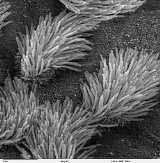
Cilium
Overview
A cilium is an organelle
found in eukaryotic
cell
s. Cilia are slender protuberances that project from the much larger cell body
.
There are two types of cilia: motile cilia and non-motile, or primary cilia, which typically serve as sensory organelles. In eukaryotes, cilia and flagella together make up a group of organelles known as undulipodia.
Eukaryotic cilia are structurally identical to Eukaryotic flagella, although distinctions are sometimes made according to function and/or length.
Cilia are rare in most plants, occurring most notably in cycad
s.
Cilia can be divided into primary and motile forms.
Larger eukaryotes, such as mammals, have motile cilia as well.
Organelle
In cell biology, an organelle is a specialized subunit within a cell that has a specific function, and is usually separately enclosed within its own lipid bilayer....
found in eukaryotic
Eukaryote
A eukaryote is an organism whose cells contain complex structures enclosed within membranes. Eukaryotes may more formally be referred to as the taxon Eukarya or Eukaryota. The defining membrane-bound structure that sets eukaryotic cells apart from prokaryotic cells is the nucleus, or nuclear...
cell
Cell (biology)
The cell is the basic structural and functional unit of all known living organisms. It is the smallest unit of life that is classified as a living thing, and is often called the building block of life. The Alberts text discusses how the "cellular building blocks" move to shape developing embryos....
s. Cilia are slender protuberances that project from the much larger cell body
Cell (biology)
The cell is the basic structural and functional unit of all known living organisms. It is the smallest unit of life that is classified as a living thing, and is often called the building block of life. The Alberts text discusses how the "cellular building blocks" move to shape developing embryos....
.
There are two types of cilia: motile cilia and non-motile, or primary cilia, which typically serve as sensory organelles. In eukaryotes, cilia and flagella together make up a group of organelles known as undulipodia.
Eukaryotic cilia are structurally identical to Eukaryotic flagella, although distinctions are sometimes made according to function and/or length.
Cilia are rare in most plants, occurring most notably in cycad
Cycad
Cycads are seed plants typically characterized by a stout and woody trunk with a crown of large, hard and stiff, evergreen leaves. They usually have pinnate leaves. The individual plants are either all male or all female . Cycads vary in size from having a trunk that is only a few centimeters...
s.
Cilia can be divided into primary and motile forms.
Larger eukaryotes, such as mammals, have motile cilia as well.

